#iot device management company
Explore tagged Tumblr posts
Text
Navigating the IoT Ecosystem: Unveiling the Top IoT Device Management Companies
In the dynamic landscape of the Internet of Things (IoT), where billions of interconnected devices are reshaping industries and lifestyles, effective device management is paramount. IoT device management companies play a pivotal role in ensuring the seamless operation, security, and scalability of IoT deployments. In this article, we delve into the realm of IoT device management, spotlighting leading companies driving innovation in this critical sector.

The Significance of IoT Device Management
As IoT ecosystems continue to expand, encompassing a diverse array of devices spanning industries such as healthcare, manufacturing, transportation, and smart cities, the need for robust device management solutions becomes increasingly apparent. IoT device management encompasses a range of functionalities, including:
Device Provisioning: Onboarding and provisioning devices onto the network securely and efficiently.
Configuration Management: Remote configuration and management of device settings and parameters.
Monitoring and Diagnostics: Real-time monitoring of device health, performance, and status, as well as diagnostics and troubleshooting.
Firmware Updates: Over-the-air (OTA) firmware updates to ensure devices are running the latest software versions with patches and security enhancements.
Security and Compliance: Implementing security measures such as authentication, encryption, and access control to safeguard devices and data, as well as ensuring compliance with industry regulations and standards.
Top IoT Device Management Companies
Microsoft Azure IoT: Microsoft's Azure IoT platform offers comprehensive device management capabilities through Azure IoT Hub. With features such as device provisioning service, device twin management, and over-the-air updates, Azure IoT enables secure and scalable management of IoT devices deployed in various environments.
IBM Watson IoT: IBM Watson IoT provides a robust device management solution that enables organizations to efficiently manage and monitor their IoT devices at scale. With features like device registration, configuration management, and software updates, IBM Watson IoT empowers businesses to drive operational efficiencies and optimize device performance.
AWS IoT Device Management: Amazon Web Services (AWS) offers a suite of IoT device management services under AWS IoT, including AWS IoT Device Management. This service allows organizations to onboard, organize, and remotely manage IoT devices at scale, with capabilities such as bulk registration, fleet indexing, and device shadowing.
Cisco IoT Control Center: Cisco IoT Control Center provides a comprehensive platform for managing cellular-connected IoT devices. With features like device provisioning, connectivity management, and real-time diagnostics, Cisco IoT Control Center enables organizations to streamline device lifecycle management and optimize connectivity costs.
Sierra Wireless Octave: Sierra Wireless Octave is a comprehensive IoT platform that includes device management capabilities for cellular-connected devices. With features like device provisioning, configuration management, and firmware updates, Sierra Wireless Octave simplifies the deployment and management of IoT solutions across diverse industries.
Emerging Trends and Future Outlook
As the IoT landscape continues to evolve, several trends are shaping the future of IoT device management:
Edge Computing: The integration of edge computing capabilities into device management solutions enables localized processing and decision-making, reducing latency and bandwidth requirements.
AI and Analytics: The use of artificial intelligence (AI) and advanced analytics enhances device management capabilities, enabling predictive maintenance, anomaly detection, and optimization of device performance.
Blockchain Integration: Blockchain technology is being explored to enhance the security, integrity, and traceability of device management operations, particularly in industries with stringent regulatory requirements.
Interoperability and Standards: Efforts to standardize device management protocols and ensure interoperability among IoT devices facilitate seamless integration and management across heterogeneous IoT ecosystems.
In conclusion, IoT device management companies play a crucial role in enabling the seamless operation and optimization of IoT deployments across industries. By leveraging innovative technologies and best practices, these companies empower organizations to harness the full potential of IoT, driving efficiency, innovation, and growth in the digital age.
0 notes
Text
IoT Development; A Complete Guide, on Bringing Devices from Idea to Implementation
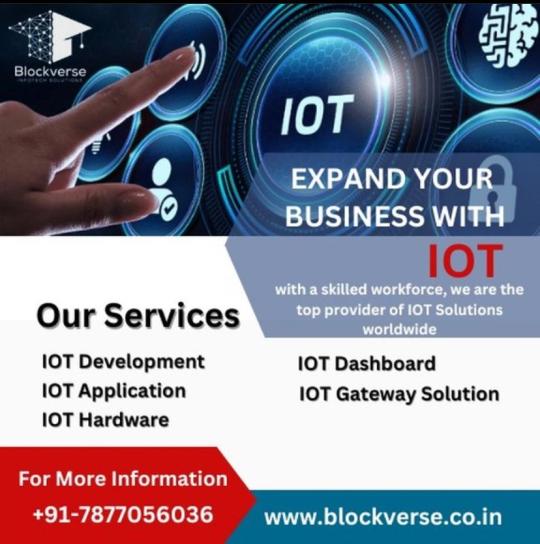
In todays paced tech world, the Internet of Things (IoT) has emerged as a game changer transforming the way we engage with our environment. At Blockverse Infotech Solutions we recognize the power of devices providing customized solutions to bring ideas to life and seamlessly integrate them into the digital realm.
The Internet of Things (IoT) has evolved from a buzzword to an aspect of contemporary technology influencing various facets of our everyday routines. From homes and wearable gadgets to automation and healthcare systems IoT enables us to connect and empower ourselves like never before. However transitioning from conceptualization to implementation of solutions can be overwhelming without guidance.
Conceptualization marks the phase, in IoT development. It entails identifying the problem or opportunity that can be addressed through technology and envisioning how interconnected devices can improve efficiency, convenience or safety. At Blockverse Infotech Solutions we work closely with clients to brainstorm ideas grasp their needs and devise IoT solutions tailored specifically for them.
Once the concept is solidified, the development phase begins. This involves designing and prototyping IoT devices, selecting appropriate sensors and connectivity protocols, and developing the software infrastructure to collect, analyze, and act upon data generated by the devices. Our team of skilled developers and engineers at Blockverse Infotech Solutions leverages cutting-edge technologies to build robust and scalable IoT solutions that meet the highest standards of performance and reliability.
Testing and validation are integral parts of the development process, ensuring that IoT devices function as intended and deliver the desired outcomes. Through rigorous testing procedures and simulation environments, we identify and rectify any issues or vulnerabilities, ensuring that the deployed IoT solutions operate seamlessly in real-world scenarios.
Deployment marks the culmination of the IoT development journey, as the solutions are implemented and integrated into existing systems or environments. From device provisioning and network configuration to data management and security protocols, our experts at Blockverse Infotech Solutions handle every aspect of the deployment process with precision and care, ensuring a smooth transition from development to operation.
Post-deployment support and maintenance are essential for ensuring the long-term success and sustainability of IoT solutions. At Blockverse Infotech Solutions, we offer comprehensive support services, including monitoring, troubleshooting, and software updates, to keep IoT devices running smoothly and efficiently.
In conclusion, navigating the complex landscape of IoT development requires expertise, innovation, and a comprehensive understanding of the technology. With Blockverse Infotech Solutions providing tailored solutions for IoT devices, businesses and organizations can embark on their IoT journey with confidence, knowing that they have a trusted partner to guide them from concept to deployment and beyond.
#internet of things#iot#iot devices#iot projects#iot applications#iot development company#iot device management software#embedded system design#iot device management app#embedded operating system#iot monitoring software#embedded systems#what is embedded system
0 notes
Text
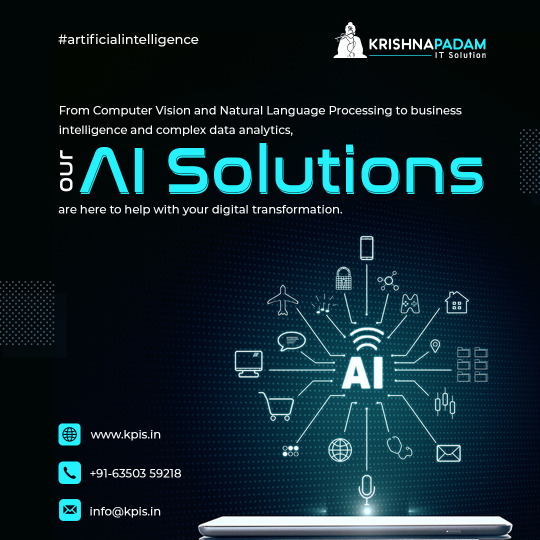
𝐀𝐑𝐓𝐈𝐅𝐈𝐂𝐈𝐀𝐋 𝐈𝐍𝐓𝐄𝐋𝐋𝐈𝐆𝐄𝐍𝐂𝐄 is rapidly developing and playing an essential role in business intelligence (BI) and analytics in today’s data-driven business prospect. With advanced capabilities in data collection, analysis, and decision-making, #ai has the potential to transform how businesses approach data-driven strategies.
𝐀𝐈 𝐀𝐏𝐏 𝐃𝐄𝐕𝐄𝐋𝐎𝐏𝐌𝐄𝐍𝐓 𝐒𝐄𝐑𝐕𝐈𝐂𝐄𝐒 are valuable in different industries, including #healthcare, #finance, #ecommerce, #manufacturing, transport, #customerservice, #marketing, #cybersecurity, and many more. With AI-driven applications, businesses can streamline operations, enhance productivity, and provoke growth.
𝐎𝐔𝐑 𝐀𝐑𝐓𝐈𝐅𝐈𝐂𝐈𝐀𝐋 𝐈𝐍𝐓𝐄𝐋𝐋𝐈𝐆𝐄𝐍𝐂𝐄 𝐒𝐄𝐑𝐕𝐈𝐂𝐄𝐒: 🔻 Deep Learning 🔺 Computer Vision 🔻 Machine Learning 🔺 Predictive Analytics 🔻 Custom AI Solutions 🔺 AI Conversational Tools 🔻 Natural Language Processing
Our team develops digital artificial intelligence (AI) solutions from the ground up or incorporates them into existing business systems using predictive analytics tools. We transform legacy and extensive data into reusable datasets for multi-label category, regression, and gathering before deploying the prototypes. With our AI development services, you can combine Artificial Intelligence into your existing products to speed up the decision-making technique.
Would you like to understand how #kpis helps you to achieve your AI visions? Contact us today to understand more about 𝐀𝐈 𝐃𝐄𝐕𝐄𝐋𝐎𝐏𝐌𝐄𝐍𝐓 𝐒𝐄𝐑𝐕𝐈𝐂𝐄𝐒, and let us be your partner in optimising operational effectiveness and improving customer experience.
🔊𝐆𝐞𝐭 𝐢𝐧 𝐓𝐨𝐮𝐜𝐡 𝐖𝐢𝐭𝐡 𝐔𝐬🔊 ➖➖➖➖➖➖➖➖ 🌐 𝐕𝐢𝐬𝐢𝐭: https://www.kpis.in/ai-development-company 📧 𝐄𝐦𝐚𝐢𝐥: [email protected] 📞 𝐂𝐨𝐧𝐭𝐚𝐜𝐭: +91-6350359218 ➖➖➖➖➖➖➖➖
#artificial intelligence#ai app development#machine learning#deep learning#computer vision#natural language processing#ai solutions#ai services#chatbot#ai technology#iot app development#iiot#information technology#app development#mobile device management#mobile app development company#web development#game development company#technology#application development#software development company
0 notes
Text
Explore Squillion Tech's IoT services and take your business to the next level with the latest technology solutions. Our team of experts can help you implement the Internet of Things to streamline operations, improve efficiency, and enhance customer experience. Visit here: https://www.squillion.tech/services/iot-services/
#iot services#iot application development#iot app development company#iot device management solutions#iot development services#iot business solutions#iot app development services#iot software development services#custom iot development company
0 notes
Text
Pest Control Market Insights Health and Hygiene Awareness Driving Preventive Solutions
The pest control market is a dynamic industry influenced by evolving consumer demands, regulatory frameworks, and technological advancements. This article delves into key insights about the pest control market, highlighting factors driving growth, challenges, and opportunities for innovation.

Pest Control Market Insights: Urbanization Driving Demand
Rapid urbanization has led to increased pest infestations in cities, requiring effective management strategies. Dense housing developments and waste mismanagement provide fertile grounds for pests, pushing urban consumers and municipalities to seek professional pest control services.
Pest Control Market Insights: Focus on Sustainable Solutions
Consumers and businesses are increasingly favoring environmentally friendly pest control options. The demand for biopesticides, organic repellents, and integrated pest management (IPM) techniques has surged, reflecting a shift toward sustainability within the industry.
Pest Control Market Insights: Technological Advancements in Pest Control
Technology is transforming pest control methods. Innovations such as AI-powered pest monitoring, IoT devices for real-time detection, and drone-based pest spraying systems are enhancing efficiency and precision, catering to both residential and industrial needs.
Pest Control Market Insights: Agriculture Sector and Pest Management
Agricultural pest control is critical for ensuring food security and maximizing crop yields. Precision agriculture, biological pest control methods, and automated pest monitoring systems are becoming integral to managing pests in farming.
Pest Control Market Insights: Commercial Sector Expansion
The commercial pest control market is growing significantly as industries like hospitality, food processing, and healthcare prioritize pest management for regulatory compliance and customer safety. Commercial facilities are investing heavily in regular pest inspections and preventive measures.
Pest Control Market Insights: Health and Hygiene Awareness
Heightened awareness about health risks associated with pests, such as disease transmission and allergic reactions, is driving consumers to opt for preventive pest control measures. The focus on hygiene has intensified in the wake of global pandemics.
Pest Control Market Insights: Challenges in Rural Areas
While urban areas have easy access to pest control services, rural regions face challenges such as limited service providers and lack of awareness. Addressing these gaps presents a significant growth opportunity for the pest control market.
Pest Control Market Insights: Regulatory Landscape and Compliance
Strict regulations governing pesticide use and environmental protection are reshaping the pest control industry. Companies must invest in compliance and innovation to meet regulatory standards while delivering effective solutions.
Pest Control Market Insights: Mergers and Strategic Alliances
Mergers, acquisitions, and collaborations among pest control companies are driving market consolidation. Strategic alliances help businesses expand their service offerings, adopt new technologies, and enhance their market presence.
Conclusion: Unlocking Potential in the Pest Control Market
The pest control market offers immense growth opportunities, driven by urbanization, health awareness, and technological advancements. However, addressing challenges such as sustainability, rural access, and regulatory compliance is essential. By focusing on innovation, eco-friendly solutions, and strategic collaborations, the pest control industry can achieve long-term growth and success.
#Pest Control Market#Pest Control Market trends#Pest Control#pest control company#pest regretevator#pest control services
4 notes
·
View notes
Text

The Federal Bureau of Investigation (FBI), Cyber National Mission Force (CNMF), and National Security Agency (NSA) assess that People’s Republic of China (PRC)-linked cyber actors have compromised thousands of Internet-connected devices, including small office/home office (SOHO) routers, firewalls, network-attached storage (NAS) and Internet of Things (IoT) devices with the goal of creating a network of compromised nodes (a “botnet”) positioned for malicious activity. The actors may then use the botnet as a proxy to conceal their identities while deploying distributed denial of service (DDoS) attacks or compromising targeted U.S. networks.
Integrity Technology Group, a PRC-based company, has controlled and managed a botnet active since mid- 2021. The botnet has regularly maintained between tens to hundreds of thousands of compromised devices. As of June 2024, the botnet consisted of over 260,000 devices. Victim devices part of the botnet have been observed in North America, South America, Europe, Africa, Southeast Asia and Australia.
While devices aged beyond their end-of-life dates are known to be more vulnerable to intrusion, many of the compromised devices in the Integrity Tech controlled botnet are likely still supported by their respective vendors.
FBI, CNMF, NSA, and allied partners are releasing this Joint Cyber Security Advisory to highlight the threat posed by these actors and their botnet activity and to encourage exposed device vendors, owners, and operators to update and secure their devices from being compromised and joining the botnet. Network defenders are advised to follow the guidance in the mitigations section to protect against the PRC-linked cyber actors’ botnet activity. Cyber security companies can also leverage the information in this advisory to assist with identifying malicious activity and reducing the number of devices present in botnets worldwide.
For additional information, see U.S. Department of Justice (DOJ) press release....
4 notes
·
View notes
Text
How to Choose the Best ERP for Engineering and Manufacturing Industry
In today’s fast-paced world, engineering and manufacturing companies face increasing pressure to deliver high-quality products while maintaining efficiency and cost-effectiveness. Implementing the right Enterprise Resource Planning (ERP) software can significantly enhance operations, streamline workflows, and boost productivity. However, with numerous options available, selecting the best ERP software for the engineering and manufacturing industry can be challenging. This guide will help you navigate this decision-making process and choose the most suitable solution for your business.
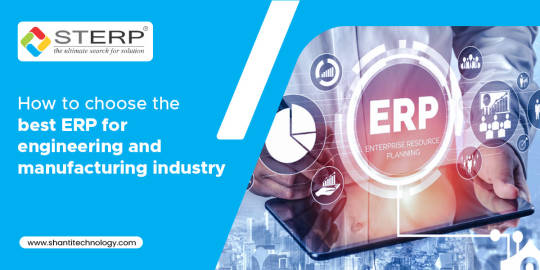
Why ERP is Crucial for Engineering and Manufacturing
ERP software integrates various business processes, including production, inventory management, supply chain, finance, and human resources. For engineering and manufacturing companies, ERP solutions are particularly vital because they:
Facilitate real-time data sharing across departments.
Enhance supply chain management.
Optimize production planning and scheduling.
Ensure compliance with industry standards.
Reduce operational costs.
Partnering with the right Engineering ERP software company ensures that your organization leverages these benefits to stay competitive in a dynamic market.
Steps to Choose the Best ERP for Engineering and Manufacturing
1. Understand Your Business Needs
Before exploring ERP solutions, evaluate your company’s specific requirements. Identify the pain points in your current processes and prioritize the features you need in an ERP system. Common features for engineering and manufacturing companies include:
Bill of Materials (BOM) management
Production planning and scheduling
Inventory control
Quality management
Financial reporting
Consulting with a reputed ERP software company can help you match your needs with the right features.
2. Look for Industry-Specific Solutions
Generic ERP software might not address the unique needs of the engineering and manufacturing sector. Opt for an ERP software in India that offers modules tailored to your industry. Such solutions are designed to handle specific challenges like multi-level BOM, project costing, and shop floor management.
3. Check Vendor Expertise
Choosing a reliable vendor is as important as selecting the software itself. Research ERP solution providers with a strong track record in serving engineering and manufacturing companies. Look for reviews, case studies, and client testimonials to gauge their expertise.
4. Evaluate Scalability and Flexibility
Your business will grow, and so will your operational requirements. Ensure that the ERP system you choose is scalable and flexible enough to accommodate future needs. The top 10 ERP software providers in India offer scalable solutions that can adapt to changing business demands.
5. Assess Integration Capabilities
An ERP system must integrate seamlessly with your existing tools, such as Computer-Aided Design (CAD) software, Customer Relationship Management (CRM) systems, and IoT devices. A well-integrated system reduces redundancies and enhances efficiency.
6. Prioritize User-Friendliness
A complex system with a steep learning curve can hinder adoption. Choose an ERP software with an intuitive interface and easy navigation. This ensures that your employees can use the system effectively without extensive training.
7. Consider Customization Options
No two businesses are alike. While standard ERP solutions offer core functionalities, some companies require customization to align with specific workflows. A trusted ERP software company in India can provide custom modules tailored to your unique needs.
8. Focus on Data Security
Engineering and manufacturing companies often deal with sensitive data. Ensure that the ERP solution complies with the latest security standards and offers robust data protection features.
9. Compare Pricing and ROI
While cost is an important factor, it should not be the sole criterion. Evaluate the long-term return on investment (ROI) offered by different ERP software. A slightly expensive but feature-rich solution from the best ERP software provider in India may deliver better value than a cheaper alternative with limited functionalities.
10. Test Before You Commit
Most ERP software companies offer free trials or demo versions. Use these opportunities to test the software in a real-world scenario. Gather feedback from your team and ensure the solution meets your expectations before finalizing your decision.
Benefits of Partnering with the Best ERP Software Providers in India
India is home to some of the leading ERP software providers in India, offering state-of-the-art solutions for the engineering and manufacturing sector. Partnering with a reputable provider ensures:
Access to advanced features tailored to your industry.
Reliable customer support.
Comprehensive training and implementation services.
Regular updates and enhancements to the software.
Companies like Shantitechnology (STERP) specialize in delivering cutting-edge ERP solutions that cater specifically to engineering and manufacturing businesses. With years of expertise, they rank among the top 10 ERP software providers in India, ensuring seamless integration and exceptional performance.
Conclusion
Selecting the right ERP software is a critical decision that can impact your company’s efficiency, productivity, and profitability. By understanding your requirements, researching vendors, and prioritizing features like scalability, integration, and security, you can find the perfect ERP solution for your engineering or manufacturing business.
If you are looking for a trusted ERP software company in India, consider partnering with a provider like STERP. As one of the best ERP software providers in India, STERP offers comprehensive solutions tailored to the unique needs of engineering and manufacturing companies. With their expertise, you can streamline your operations, improve decision-making, and stay ahead in a competitive market.
Get in touch with STERP – the leading Engineering ERP software company – to transform your business with a reliable and efficient ERP system. Take the first step toward a smarter, more connected future today!
#Manufacturing ERP software company#ERP solution provider#Engineering ERP software company#ERP software company#ERP software companies
4 notes
·
View notes
Text
Top Trends in Software Development for 2025
The software development industry is evolving at an unprecedented pace, driven by advancements in technology and the increasing demands of businesses and consumers alike. As we step into 2025, staying ahead of the curve is essential for businesses aiming to remain competitive. Here, we explore the top trends shaping the software development landscape and how they impact businesses. For organizations seeking cutting-edge solutions, partnering with the Best Software Development Company in Vadodara, Gujarat, or India can make all the difference.
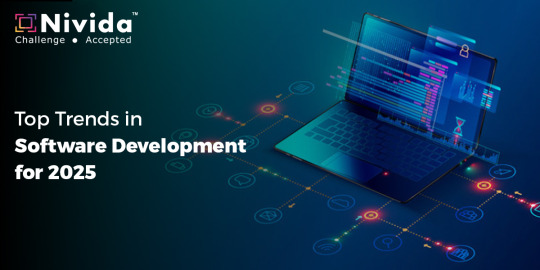
1. Artificial Intelligence and Machine Learning Integration:
Artificial Intelligence (AI) and Machine Learning (ML) are no longer optional but integral to modern software development. From predictive analytics to personalized user experiences, AI and ML are driving innovation across industries. In 2025, expect AI-powered tools to streamline development processes, improve testing, and enhance decision-making.
Businesses in Gujarat and beyond are leveraging AI to gain a competitive edge. Collaborating with the Best Software Development Company in Gujarat ensures access to AI-driven solutions tailored to specific industry needs.
2. Low-Code and No-Code Development Platforms:
The demand for faster development cycles has led to the rise of low-code and no-code platforms. These platforms empower non-technical users to create applications through intuitive drag-and-drop interfaces, significantly reducing development time and cost.
For startups and SMEs in Vadodara, partnering with the Best Software Development Company in Vadodara ensures access to these platforms, enabling rapid deployment of business applications without compromising quality.
3. Cloud-Native Development:
Cloud-native technologies, including Kubernetes and microservices, are becoming the backbone of modern applications. By 2025, cloud-native development will dominate, offering scalability, resilience, and faster time-to-market.
The Best Software Development Company in India can help businesses transition to cloud-native architectures, ensuring their applications are future-ready and capable of handling evolving market demands.
4. Edge Computing:
As IoT devices proliferate, edge computing is emerging as a critical trend. Processing data closer to its source reduces latency and enhances real-time decision-making. This trend is particularly significant for industries like healthcare, manufacturing, and retail.
Organizations seeking to leverage edge computing can benefit from the expertise of the Best Software Development Company in Gujarat, which specializes in creating applications optimized for edge environments.
5. Cybersecurity by Design:
With the increasing sophistication of cyber threats, integrating security into the development process has become non-negotiable. Cybersecurity by design ensures that applications are secure from the ground up, reducing vulnerabilities and protecting sensitive data.
The Best Software Development Company in Vadodara prioritizes cybersecurity, providing businesses with robust, secure software solutions that inspire trust among users.
6. Blockchain Beyond Cryptocurrencies:
Blockchain technology is expanding beyond cryptocurrencies into areas like supply chain management, identity verification, and smart contracts. In 2025, blockchain will play a pivotal role in creating transparent, tamper-proof systems.
Partnering with the Best Software Development Company in India enables businesses to harness blockchain technology for innovative applications that drive efficiency and trust.
7. Progressive Web Apps (PWAs):
Progressive Web Apps (PWAs) combine the best features of web and mobile applications, offering seamless experiences across devices. PWAs are cost-effective and provide offline capabilities, making them ideal for businesses targeting diverse audiences.
The Best Software Development Company in Gujarat can develop PWAs tailored to your business needs, ensuring enhanced user engagement and accessibility.
8. Internet of Things (IoT) Expansion:
IoT continues to transform industries by connecting devices and enabling smarter decision-making. From smart homes to industrial IoT, the possibilities are endless. In 2025, IoT solutions will become more sophisticated, integrating AI and edge computing for enhanced functionality.
For businesses in Vadodara and beyond, collaborating with the Best Software Development Company in Vadodara ensures access to innovative IoT solutions that drive growth and efficiency.
9. DevSecOps:
DevSecOps integrates security into the DevOps pipeline, ensuring that security is a shared responsibility throughout the development lifecycle. This approach reduces vulnerabilities and ensures compliance with industry standards.
The Best Software Development Company in India can help implement DevSecOps practices, ensuring that your applications are secure, scalable, and compliant.
10. Sustainability in Software Development:
Sustainability is becoming a priority in software development. Green coding practices, energy-efficient algorithms, and sustainable cloud solutions are gaining traction. By adopting these practices, businesses can reduce their carbon footprint and appeal to environmentally conscious consumers.
Working with the Best Software Development Company in Gujarat ensures access to sustainable software solutions that align with global trends.
11. 5G-Driven Applications:
The rollout of 5G networks is unlocking new possibilities for software development. Ultra-fast connectivity and low latency are enabling applications like augmented reality (AR), virtual reality (VR), and autonomous vehicles.
The Best Software Development Company in Vadodara is at the forefront of leveraging 5G technology to create innovative applications that redefine user experiences.
12. Hyperautomation:
Hyperautomation combines AI, ML, and robotic process automation (RPA) to automate complex business processes. By 2025, hyperautomation will become a key driver of efficiency and cost savings across industries.
Partnering with the Best Software Development Company in India ensures access to hyperautomation solutions that streamline operations and boost productivity.
13. Augmented Reality (AR) and Virtual Reality (VR):
AR and VR technologies are transforming industries like gaming, education, and healthcare. In 2025, these technologies will become more accessible, offering immersive experiences that enhance learning, entertainment, and training.
The Best Software Development Company in Gujarat can help businesses integrate AR and VR into their applications, creating unique and engaging user experiences.
Conclusion:
The software development industry is poised for significant transformation in 2025, driven by trends like AI, cloud-native development, edge computing, and hyperautomation. Staying ahead of these trends requires expertise, innovation, and a commitment to excellence.
For businesses in Vadodara, Gujarat, or anywhere in India, partnering with the Best Software Development Company in Vadodara, Gujarat, or India ensures access to cutting-edge solutions that drive growth and success. By embracing these trends, businesses can unlock new opportunities and remain competitive in an ever-evolving digital landscape.
#Best Software Development Company in Vadodara#Best Software Development Company in Gujarat#Best Software Development Company in India#nividasoftware
5 notes
·
View notes
Text
Dubai's Smart City strategy
Dubai's Smart City Strategy is an ambitious initiative aimed at transforming the city into a global leader in technology, innovation, and sustainability. Launched by the Dubai government, this comprehensive strategy leverages digital technologies and data-driven insights to improve the lives of residents, enhance government services, and foster economic growth.
Key Pillars of Dubai's Smart City Strategy
Digital Transformation: At the core of the strategy is the digitization of government services. This includes providing online access to public services, streamlining administrative processes, and implementing paperless transactions. The goal is to create a seamless and efficient experience for residents and businesses when interacting with the government.
Data-Driven Decision Making: Dubai's Smart City strategy emphasizes the collection and analysis of data to inform decision-making and improve city management. This includes using sensors and IoT devices to gather data on traffic flow, energy consumption, and environmental conditions. By analyzing this data, the city can optimize resource allocation, improve infrastructure planning, and enhance public safety.
Technological Innovation: Dubai is actively promoting the development and adoption of cutting-edge technologies, such as artificial intelligence, blockchain, and cloud computing. This includes supporting research and development initiatives, fostering partnerships with technology companies, and creating a regulatory environment that encourages innovation.
Sustainability: A key focus of the strategy is to create a sustainable and environmentally friendly city. This includes initiatives to promote energy efficiency, reduce carbon emissions, and encourage the use of renewable energy sources. Dubai is also investing in green infrastructure, such as parks and green spaces, to improve the quality of life for residents.
Citizen Engagement: The Smart City strategy emphasizes the importance of citizen engagement and participation. This includes creating platforms for residents to provide feedback, share ideas, and contribute to the development of the city. The goal is to create a sense of community ownership and ensure that the Smart City initiatives align with the needs and aspirations of the people.
Key Initiatives and Achievements
Happiness Meter: Dubai has implemented a "Happiness Meter" to gauge citizen satisfaction with public services and city initiatives. This real-time feedback system helps the government identify areas for improvement and prioritize projects that enhance the well-being of residents.
Paperless Strategy: Dubai has launched a "Paperless Strategy" aimed at eliminating paper transactions in government offices. This initiative has significantly reduced paper consumption, streamlined administrative processes, and improved efficiency.
Smart Mobility: Dubai is investing in smart mobility solutions, such as autonomous vehicles, smart traffic management systems, and integrated public transportation networks. These initiatives aim to reduce traffic congestion, improve road safety, and enhance the overall transportation experience.
Blockchain Strategy: Dubai is exploring the use of blockchain technology to enhance security, transparency, and efficiency in various sectors, including government services, logistics, and healthcare.
AI Lab: Dubai has established an AI Lab to develop and deploy artificial intelligence solutions for city management. This includes initiatives such as using AI to optimize traffic flow, improve public safety, and enhance the efficiency of government services.
Impact and Future Outlook
Dubai's Smart City strategy has already made significant progress in transforming the city into a technologically advanced and sustainable urban center. The initiatives have improved the efficiency of government services, enhanced the quality of life for residents, and attracted investment and innovation.
In the future, Dubai aims to further leverage technology to create a city that is not only smart but also resilient, inclusive, and human-centered. The focus will be on using technology to address challenges such as climate change, social inequality, and economic diversification. By continuing to invest in innovation and prioritize the needs of its citizens, Dubai is poised to become a global model for smart city development.
#Dubai's Smart City strategy#Dubai's Smart City#dubai#dubailife#dubairealestate#abu dhabi#services#uaebusiness#startup#business#dubaivape#jobs in dubai
2 notes
·
View notes
Text
The Critical Role of Structured Cabling in Today's Digital World
In today’s fast-paced, technology-driven world, structured cabling plays a vital role in keeping businesses and homes connected. Whether it’s for data, voice, or video, a well-organized cabling system is the backbone of any communication network. With the increasing demand for high-speed, reliable connections, structured cabling has become more important than ever before. This article explores the significance of structured cabling, how it supports modern technology, and why it’s essential for both businesses and residential setups.

What is Structured Cabling?
Structured cabling refers to the standardized approach used to organize and install cables that carry data and communication signals. It’s a complete system of cabling and associated hardware, designed to provide a comprehensive telecommunications infrastructure.
This type of cabling supports a wide range of applications, including internet, phone systems, and video conferencing. By creating a structured layout, this system ensures efficient data flow and makes it easier to manage upgrades, changes, or troubleshooting.
Structured cabling systems are divided into six main components: entrance facilities, backbone cabling, horizontal cabling, telecommunications rooms, work area components, and equipment rooms. These components work together to create a seamless communication network.
The Benefits of Structured Cabling
The primary benefit of structured cabling is its ability to support high-performance networks. It’s designed to handle large volumes of data, ensuring that businesses can operate without interruption.
Additionally, structured cabling offers flexibility. It allows for the easy addition of new devices and systems without needing to overhaul the entire infrastructure. This scalability is especially important in today’s world, where technology is constantly evolving.
Structured cabling also enhances efficiency. It reduces the risk of downtime by providing a reliable, organized system that is easy to manage. Troubleshooting and maintenance become simpler, saving businesses time and resources.
Finally, structured cabling offers future-proofing. With this type of system, businesses can stay ahead of technological advancements, as it supports higher data transfer rates and new technologies like 5G and IoT.
How Structured Cabling Supports Modern Technology
As technology advances, the need for fast and reliable data transmission grows. Structured cabling supports a wide range of modern technologies that are critical for businesses and homes.
For businesses, having a robust structured cabling system is essential for running daily operations. From cloud computing to video conferencing, every aspect of a company’s communication relies on a solid network foundation. Employees need to access data quickly, collaborate in real-time, and use cloud-based software efficiently. Without structured cabling, these tasks become more difficult and less reliable.
In homes, structured cabling ensures that entertainment systems, smart devices, and internet connections run smoothly. As smart home technology becomes more prevalent, having a reliable cabling system in place is key to integrating these devices and maintaining their performance.
The Importance of Structured Cabling in Data Centers
Data centers are the heart of any company’s IT infrastructure, and structured cabling is critical to their success. These facilities store vast amounts of data and support essential business functions like email, file storage, and cloud services.
A structured cabling system in a data center enables efficient communication between servers, storage systems, and network devices. It allows data to move quickly and reliably across the network. Without it, data centers would struggle with congestion, leading to slower performance and increased downtime.
The efficiency and scalability of structured cabling make it ideal for data centers, where the demand for faster data transmission is always growing. With the rise of cloud computing, IoT, and big data, structured cabling has become more critical than ever in keeping data centers running at peak performance.
Why Structured Cabling is Crucial for Future Growth
As technology continues to evolve, businesses need to be prepared for future growth. Structured cabling provides the foundation for that growth by offering a scalable, flexible solution that can adapt to new technologies.
One of the most significant trends in technology today is the rise of the Internet of Things (IoT). IoT devices, such as smart sensors and connected appliances, rely on strong network connections to function properly. A structured cabling system ensures that these devices can communicate with each other seamlessly, supporting the expanding ecosystem of connected technology.
Additionally, structured cabling supports faster internet speeds and higher bandwidth, both of which are essential for businesses and homes. With the rise of 5G and other advanced technologies, having a robust cabling infrastructure will be crucial for staying competitive and keeping up with the demands of modern technology.
Working with Professionals for Installation
Installing structured cabling requires expertise, as it’s a complex process that involves designing a layout, selecting the right cables, and ensuring everything is properly organized. This is where working with professionals becomes important.
For businesses or homeowners searching for networking services near me, it's essential to work with a contractor who understands the unique needs of each project. Whether upgrading an existing system or installing new cabling from scratch, experienced professionals can design and implement a system that ensures optimal performance.
Professional installation not only guarantees that the system is set up correctly, but also minimizes the risk of future issues. With their expertise, they can ensure that your structured cabling system is scalable, efficient, and capable of supporting future technologies.

Conclusion
Structured cabling is the backbone of today’s digital world, providing the reliable infrastructure needed for businesses and homes to stay connected. It supports the rapid growth of modern technologies like cloud computing, IoT, and 5G, while also offering flexibility and scalability for future advancements.
For anyone looking to enhance their network performance, investing in structured cabling is a smart choice. It’s an investment in efficiency, reliability, and the future of technology. By working with professionals who understand the importance of structured cabling, you can ensure that your communication infrastructure is ready to meet the demands of today and tomorrow.
2 notes
·
View notes
Text
How IoT Application Development is Transforming Smart Cities and Homes?

IoT Application Development is becoming a major actor in transforming residential and commercial environments in the current society. The development of IoT technology has made it possible for smart homes and smart cities—where IoT-enabled smart devices cooperate to offer an improved living environment.
This change addresses sustainability, efficiency, safety, and convenience as well as others. Companies like SSTech System are setting the standard for IoT development and are causing a major change in our interaction with our surroundings.
The role of IoT application development in smart cities
The progress of smart cities depends much on IoT application development in Australia. IoT technology’s inclusion into urban infrastructure is enabling cities to grow more environmentally friendly, effective, and resident-responsive. Globally, smart city IoT solutions are being used since they offer real-time data and insights that help managers and municipal planners to make wise decisions.
Smart city traffic management is one of the main areas IoT application development is transforming. IoT-enabled smart devices let cities track traffic, ease congestion, and maximize public transit systems. This lowers carbon emissions, thereby helping to create sustainable smart cities, and enhancing the daily commute for residents.
IoT environmental monitoring is another quite important factor. Among other environmental elements, IoT development has made it possible to install sensors tracking air quality, noise levels, and water quality all around. This information is priceless in guaranteeing that city stays habitable and in enabling fast reactions to environmental hazards.
Management of Energy Another field where IoT application development is changing metropolitan environments is IoT. IoT technology lets cities maximize public building energy use, street lighting, and other infrastructure. In addition to saving money, this greatly helps a city’s total energy impact to be lessened.
Points to Consider:
Integration of Internet of things in urban areas depends on IoT application development.
Smart city traffic management and IoT environmental monitoring are key areas benefiting from IoT development.
Energy management IoT solutions contribute to the creation of sustainable smart cities.
Transforming Residential Spaces with IoT
IoT application development is changing homes as well as cities. Smart home technology is now a reality, with IoT development making homes more efficient, secure, and comfortable.
Among the most important developments in home IoT are home automation using IoT. From their smartphones or tablets, homeowners may manage lighting, heating, cooling, and even kitchen appliances by IoT-enabled smart devices. This not only adds convenience but also contributes to energy efficiency with IoT by ensuring that energy is not wasted when it is not needed.
Another area IoT technology that is significantly changing is security. IoT-powered smart home security systems let homeowners remotely operate locks and cameras, monitor their houses in real time, and get alarms about suspicious behavior. This level of security was unimaginable just a few years ago and is now becoming a standard feature in IoT applications for residential spaces.
The AI and IoT integration is improving the features of smart homes even further. IoT application development is letting homes learn from the behavior patterns of its occupants and automatically modify settings by integrating the power of artificial intelligence with IoT technology. This produces a more individualized and responsive living space.
Points to consider:
Home automation with IoT is making homes more convenient and energy-efficient.
Smart home security systems provide real-time monitoring and control for enhanced security.
The integration of AI and IoT is creating smarter, more responsive homes.
Transforming smart cities and smart homes: a unified vision
Beyond personal inventions, IoT application development offers a consistent future vision by transforming smart cities and smart homes. IoT technology guarantees that cities become more sensitive and flexible to the requirements of their citizens as they expand therefore ensure their adaptation.
This change involves creating interconnected infrastructure where IoT-enabled smart devices work together to enhance environmental monitoring, energy management, and public safety. At the same time, it personalizes smart homes for homeowners by providing automation, improved security, and energy efficiency.
Smart homes and smart cities working together produce a whole ecosystem where technology enhances macro and micro-level quality of living. Driven by IoT Application Development, this twofold shift is creating the foundation for a time when urban life and personal spaces will be linked, intelligent, and very efficient.
The future of IoT application development
IoT application development has high future prospects since ongoing technological developments will help to change smart homes and cities. Leading innovators in this transformation, organizations like SSTech system solutions should provide ever more complex solutions as IoT development advances.
One area of interest is the ongoing IoT smart city infrastructure integration. The possibilities for IoT for public safety, intelligent building management, and real-time IoT monitoring will just increase as more cities embrace IoT technologies. Safer, more efficient cities able to instantly meet the demands of their residents will result from this.
IoT app development will probably concentrate in residential environments on improving the features of IoT-enabled smart devices. We can expect more sophisticated and intuitive home automation using IoT systems. As more devices connect, the focus on IoT data privacy and security will become increasingly important.
Future IoT application development will be significantly influenced by SSTech System’s IoT solutions combined with emerging technologies like 5G and edge computing. These advancements will create faster and more reliable IoT networks, essential for the growth of smart homes and cities.
Points to consider:
The future of IoT Application Development will see continued advancements in IoT smart city infrastructure and home automation with IoT.
IoT data privacy and security will become increasingly important as the number of connected devices grows.
The integration of SSTech System IoT solutions with technologies like 5G will drive the next wave of IoT innovation.
Conclusion
The transformation of smart homes and smart cities is mostly dependent on IoT application development. From IoT smart city infrastructure to home automation with IoT, IoT technology is clearly seen in any sphere of our daily life. Leading the charge in this change are companies like SSTech System, which offers creative IoT solutions making our homes more safe, our cities more sustainable, and our life more convenient.
Looking ahead, the function of IoT application development in Australia will only become more important. The opportunities for smart cities and households are limitless as technology and IoT-enabled devices evolve. To unlock these possibilities, we need ongoing innovation, a commitment to IoT data privacy and security, and the integration of emerging technologies with IoT advancements.
Ultimately, the IoT Application Development’s transformation of our urban and residential areas marks not only a trend but also a basic change in our way of life and interaction with our surroundings. The future is smart, and IoT evolution is the guiding direction.
#iot#iot applications#iot development services#sstech system#software development#it consulting#IoT Development#Mobile Apps Development#Apps Development#IoT application development#smart cities#custom IoT solutions#iot consulting#software#mobile development#Hire Dedicated Developer#Australia#India#Google Trends
2 notes
·
View notes
Text
Navigating the IoT Ecosystem: Unveiling the Top IoT Device Management Companies
In the dynamic landscape of the Internet of Things (IoT), where billions of interconnected devices are reshaping industries and lifestyles, effective device management is paramount. IoT device management companies play a pivotal role in ensuring the seamless operation, security, and scalability of IoT deployments. In this article, we delve into the realm of IoT device management, spotlighting leading companies driving innovation in this critical sector.
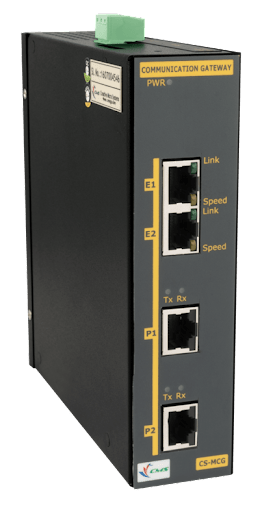
The Significance of IoT Device Management
As IoT ecosystems continue to expand, encompassing a diverse array of devices spanning industries such as healthcare, manufacturing, transportation, and smart cities, the need for robust device management solutions becomes increasingly apparent. IoT device management encompasses a range of functionalities, including:
Device Provisioning: Onboarding and provisioning devices onto the network securely and efficiently.
Configuration Management: Remote configuration and management of device settings and parameters.
Monitoring and Diagnostics: Real-time monitoring of device health, performance, and status, as well as diagnostics and troubleshooting.
Firmware Updates: Over-the-air (OTA) firmware updates to ensure devices are running the latest software versions with patches and security enhancements.
Security and Compliance: Implementing security measures such as authentication, encryption, and access control to safeguard devices and data, as well as ensuring compliance with industry regulations and standards.
Top IoT Device Management Companies
Microsoft Azure IoT: Microsoft's Azure IoT platform offers comprehensive device management capabilities through Azure IoT Hub. With features such as device provisioning service, device twin management, and over-the-air updates, Azure IoT enables secure and scalable management of IoT devices deployed in various environments.
IBM Watson IoT: IBM Watson IoT provides a robust device management solution that enables organizations to efficiently manage and monitor their IoT devices at scale. With features like device registration, configuration management, and software updates, IBM Watson IoT empowers businesses to drive operational efficiencies and optimize device performance.
AWS IoT Device Management: Amazon Web Services (AWS) offers a suite of IoT device management services under AWS IoT, including AWS IoT Device Management. This service allows organizations to onboard, organize, and remotely manage IoT devices at scale, with capabilities such as bulk registration, fleet indexing, and device shadowing.
Cisco IoT Control Center: Cisco IoT Control Center provides a comprehensive platform for managing cellular-connected IoT devices. With features like device provisioning, connectivity management, and real-time diagnostics, Cisco IoT Control Center enables organizations to streamline device lifecycle management and optimize connectivity costs.
Sierra Wireless Octave: Sierra Wireless Octave is a comprehensive IoT platform that includes device management capabilities for cellular-connected devices. With features like device provisioning, configuration management, and firmware updates, Sierra Wireless Octave simplifies the deployment and management of IoT solutions across diverse industries.
Emerging Trends and Future Outlook
As the IoT landscape continues to evolve, several trends are shaping the future of IoT device management:
Edge Computing: The integration of edge computing capabilities into device management solutions enables localized processing and decision-making, reducing latency and bandwidth requirements.
AI and Analytics: The use of artificial intelligence (AI) and advanced analytics enhances device management capabilities, enabling predictive maintenance, anomaly detection, and optimization of device performance.
Blockchain Integration: Blockchain technology is being explored to enhance the security, integrity, and traceability of device management operations, particularly in industries with stringent regulatory requirements.
Interoperability and Standards: Efforts to standardize device management protocols and ensure interoperability among IoT devices facilitate seamless integration and management across heterogeneous IoT ecosystems.
In conclusion, IoT device management companies play a crucial role in enabling the seamless operation and optimization of IoT deployments across industries. By leveraging innovative technologies and best practices, these companies empower organizations to harness the full potential of IoT, driving efficiency, innovation, and growth in the digital age.
0 notes
Text
Tamagotchi Uni Uses AWS, Amazon Web Services
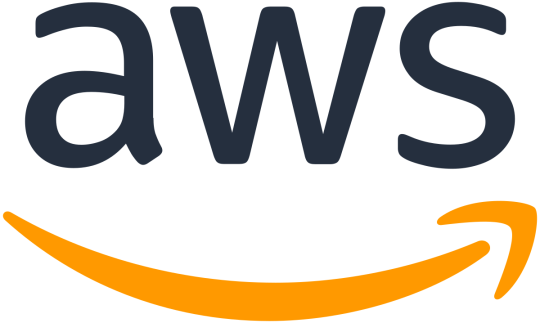
The Tamagotchi Uni is the first Tamagotchi to ever connect to Wi-Fi, which enables it to receive over the area updates, programing changes, and more. How exactly is this all being done by Bandai Japan? Well Bandai has built the Tamagotchi Uni on the Amazon Web Services platform (AWS).
The details of this are actually outlined on a recent article on the Amazon Web Services blog. The blog post provided a detailed view on how Tamagotchi Uni use AWS to achieve secure and reliable connectivity and quickly deliver new content updates without leaving customers waiting.It details that Bandai Co., Ltd., the company responsible for product development and sales, adopted AWS IoT to realize the concept of globally interconnected Tamagotchi, enabling users to interact with each other.
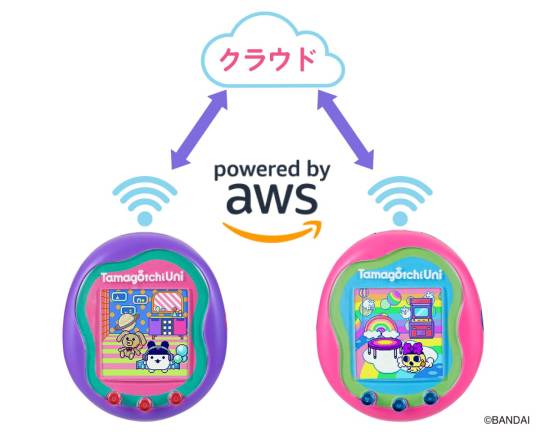
Bandai partnered with their cloud development partner, Phoenisys, Inc., to connect and manage million of Tamagotchi devices. One of the critical features was the over the air software updates which uses the jobs feature of AWS IoT Device Management to distribute the latest firmware across all Tamagotchi devices without causing any delays to customers.
To make Tamagotchi Uni IoT-enabled, Bandai establish the three key goals, which was implementing secure connections, scaling the load-balancing resources to accommodate over 1 million connections worldwide, and optimizing operational costs. The article even features the AWS architecture for the Tamagotchi Uni, which is interesting.
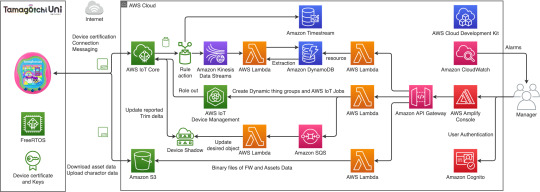
AWS IoT Core is used to manage the state of each Tamagotchi Uni device, which helps retrieve distributed items and content. AWS IoT Device Management is used to index the extensive Tamagotchi Uni fleet and create dynamic groups on the state of each device, facilitating efficient over-the-air (OTA) updates. FreeRTOS is used to minimize the amount of resources and code required to implement device-to-cloud communication for efficient system development. AWS Lambda is used to process tasks, delivering new announcements, and registering assets. Amazon DynamoDB is used as a fully managed, sever less, key-value noSQL database that runs high-performance applications at any scale. Amazon Simple Storage Service (Amazon S3) is used for object storage service, each of these data stores are used to manage the various resources within Tamagotchi Uni. Lastly, Amazon Timestream is used to accumulate historical data of user’s actions like downloading items and additional content.
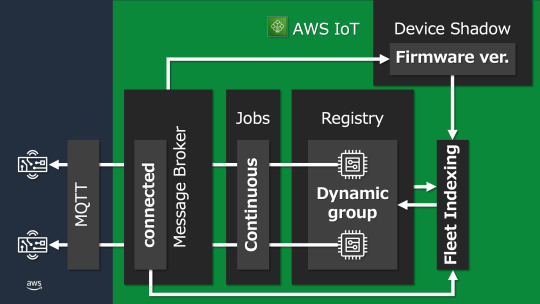
The article also details how Bandai is handling large scale firmware updates to Tamagotchi Uni devices which are executed at a rate of 1,000 units per hour which would have resulted in a delay for some devices. The team actually designed job delivery as a continuous job which automatically updates the devices under certain conditions. This is using fleet indexing that runs a query to see which devices meet the criteria for the update to be pushed out to it.
Lastly the article details how Bandai conducted system performance testing at a large-scale to emulate what it would be like after the device was released. They verified the smooth operation and performance of updates through their testing.
Be sure to check out the full article here on the Amazon AWS blog.
#tamapalace#tamagotchi#tmgc#tamagotchiuni#tamagotchi uni#uni#tamatag#virtualpet#bandai#amazonaws#amazon aws#aws#amazonwebservices#amazon web services#blog
14 notes
·
View notes
Text
How Can You Ensure Data Quality in Healthcare Analytics and Management?

Healthcare facilities are responsible for the patient’s recovery. Pharmaceutical companies and medical equipment manufacturers also work toward alleviating physical pain, stress levels, and uncomfortable body movement issues. Still, healthcare analytics must be accurate for precise diagnosis and effective clinical prescriptions. This post will discuss data quality management in the healthcare industry.
What is Data Quality in Healthcare?
Healthcare data quality management includes technologies and statistical solutions to verify the reliability of acquired clinical intelligence. A data quality manager protects databases from digital corruption, cyberattacks, and inappropriate handling. So, medical professionals can get more realistic insights using data analytics solutions.
Laboratories have started emailing the test results to help doctors, patients, and their family members make important decisions without wasting time. Also, assistive technologies merge the benefits of the Internet of Things (IoT) and artificial intelligence (AI) to enhance living standards.
However, poor data quality threatens the usefulness of healthcare data management solutions.
For example, pharmaceutical companies and authorities must apply solutions that remove mathematical outliers to perform high-precision data analytics for clinical drug trials. Otherwise, harmful medicines will reach the pharmacist’s shelf, endangering many people.
How to Ensure Data Quality in the Healthcare Industry?
Data quality frameworks utilize different strategies to prevent processing issues or losing sensitive intelligence. If you want to develop such frameworks to improve medical intelligence and reporting, the following 7 methods can aid you in this endeavor.
Method #1| Use Data Profiling
A data profiling method involves estimating the relationship between the different records in a database to find gaps and devise a cleansing strategy. Data cleansing in healthcare data management solutions has the following objectives.
Determine whether the lab reports and prescriptions match the correct patient identifiers.
If inconsistent profile matching has occurred, fix it by contacting doctors and patients.
Analyze the data structures and authorization levels to evaluate how each employee is accountable for specific patient recovery outcomes.
Create a data governance framework to enforce access and data modification rights strictly.
Identify recurring data cleaning and preparation challenges.
Brainstorm ideas to minimize data collection issues that increase your data cleaning efforts.
Ensure consistency in report formatting and recovery measurement techniques to improve data quality in healthcare.
Data cleaning and profiling allow you to eliminate unnecessary and inaccurate entries from patient databases. Therefore, healthcare research institutes and commercial life science businesses can reduce processing errors when using data analytics solutions.
Method #2| Replace Empty Values
What is a null value? Null values mean the database has no data corresponding to a field in a record. Moreover, these missing values can skew the results obtained by data management solutions used in the healthcare industry.
Consider that a patient left a form field empty. If all the care and life science businesses use online data collection surveys, they can warn the patients about the empty values. This approach relies on the “prevention is better than cure” principle.
Still, many institutions, ranging from multispecialty hospitals to clinical device producers, record data offline. Later, the data entry officers transform the filled papers using scanners and OCR (optical character recognition).
Empty fields also appear in the database management system (DBMS), so the healthcare facilities must contact the patients or reporting doctors to retrieve the missing information. They use newly acquired data to replace the null values, making the analytics solutions operate seamlessly.
Method #3| Refresh Old Records
Your physical and psychological attributes change with age, environment, lifestyle, and family circumstances. So, what was true for an individual a few years ago is less likely to be relevant today. While preserving historical patient databases is vital, hospitals and pharma businesses must periodically update obsolete medical reports.
Each healthcare business maintains a professional network of consulting physicians, laboratories, chemists, dietitians, and counselors. These connections enable the treatment providers to strategically conduct regular tests to check how patients’ bodily functions change throughout the recovery.
Therefore, updating old records in a patient’s medical history becomes possible. Other variables like switching jobs or traveling habits also impact an individual’s metabolism and susceptibility to illnesses. So, you must also ask the patients to share the latest data on their changed lifestyles. Freshly obtained records increase the relevance of healthcare data management solutions.
Method #4| Standardize Documentation
Standardization compels all professionals to collect, store, visualize, and communicate data or analytics activities using unified reporting solutions. Furthermore, standardized reports are integral to improving data governance compliance in the healthcare industry.
Consider the following principles when promoting a documentation protocol to make all reports more consistent and easily traceable.
A brand’s visual identities, like logos and colors, must not interfere with clinical data presentation.
Observed readings must go in the designated fields.
Both the offline and online document formats must be identical.
Stakeholders must permanently preserve an archived copy of patient databases with version control as they edit and delete values from the records.
All medical reports must arrange the data and insights to prevent ambiguity and misinterpretation.
Pharma companies, clinics, and FDA (food and drug administration) benefit from reporting standards. After all, corresponding protocols encourage responsible attitudes that help data analytics solutions avoid processing problems.
Method #5| Merge Duplicate Report Instances
A report instance is like a screenshot that helps you save the output of visualization tools related to a business query at a specified time interval. However, duplicate reporting instances are a significant quality assurance challenge in healthcare data management solutions.
For example, more than two nurses and one doctor will interact with the same patients. Besides, patients might consult different doctors and get two or more treatments for distinct illnesses. Such situations result in multiple versions of a patient’s clinical history.
Data analytics solutions can process the data collected by different healthcare facilities to solve the issue of duplicate report instances in the patients’ databases. They facilitate merging overlapping records and matching each patient with a universally valid clinical history profile.
Such a strategy also assists clinicians in monitoring how other healthcare professionals prescribe medicine to a patient. Therefore, they can prevent double dosage complications arising from a patient consuming similar medicines while undergoing more than one treatment regime.
Method #6| Audit the DBMS and Reporting Modules
Chemical laboratories revise their reporting practices when newly purchased testing equipment offers additional features. Likewise, DBMS solutions optimized for healthcare data management must receive regular updates.
Auditing the present status of reporting practices will give you insights into efficient and inefficient activities. Remember, there is always a better way to collect and record data. Monitor the trends in database technologies to ensure continuous enhancements in healthcare data quality.
Simultaneously, you want to assess the stability of the IT systems because unreliable infrastructure can adversely affect the decision-making associated with patient diagnosis. You can start by asking the following questions.
Questions to Ask When Assessing Data Quality in Healthcare Analytics Solutions
Can all doctors, nurses, agents, insurance representatives, patients, and each patient’s family members access the required data without problems?
How often do the servers and internet connectivity stop functioning correctly?
Are there sufficient backup tools to restore the system if something goes wrong?
Do hospitals, research facilities, and pharmaceutical companies employ end-to-end encryption (E2EE) across all electronic communications?
Are there new technologies facilitating accelerated report creation?
Will the patient databases be vulnerable to cyberattacks and manipulation?
Are the clinical history records sufficient for a robust diagnosis?
Can the patients collect the documents required to claim healthcare insurance benefits without encountering uncomfortable experiences?
Is the presently implemented authorization framework sufficient to ensure data governance in healthcare?
Has the FDA approved any of your prescribed medications?
Method #7| Conduct Skill Development Sessions for the Employees
Healthcare data management solutions rely on advanced technologies, and some employees need more guidance to use them effectively. Pharma companies are aware of this as well, because maintaining and modifying the chemical reactions involved in drug manufacturing will necessitate specialized knowledge.
Different training programs can assist the nursing staff and healthcare practitioners in developing the skills necessary to handle advanced data analytics solutions. Moreover, some consulting firms might offer simplified educational initiatives to help hospitals and nursing homes increase the skill levels of employees.
Cooperation between employees, leadership, and public authorities is indispensable to ensure data quality in the healthcare and life science industries. Otherwise, a lack of coordination hinders the modernization trends in the respective sectors.
Conclusion
Healthcare analytics depends on many techniques to improve data quality. For example, cleaning datasets to eliminate obsolete records, null values, or duplicate report instances remains essential, and multispecialty hospitals agree with this concept.
Therefore, medical professionals invest heavily in standardized documents and employee education to enhance data governance. Also, you want to prevent cyberattacks and data corruption. Consider consulting reputable firms to audit your data operations and make clinical trials more reliable.
SG Analytics is a leader in healthcare data management solutions, delivering scalable insight discovery capabilities for adverse event monitoring and medical intelligence. Contact us today if you want healthcare market research and patent tracking assistance.
3 notes
·
View notes
Text
Custom IOT Development Company - Squillion Tech
Squillion Tech is the best Custom IOT Development Company, get the best IoT solutions that align with their business goals. We work with clients to assess their existing infrastructure, determine the areas where IoT can be implemented, and develop a roadmap to deploy IoT solutions.
#custom iot development company#iot software development services#iot app development services#iot business solutions#iot development services#iot device management solutions#iot app development company#iot application development
1 note
·
View note
Text
Global top 13 companies accounted for 66% of Total Frozen Spring Roll market(qyresearch, 2021)
The table below details the Discrete Manufacturing ERP revenue and market share of major players, from 2016 to 2021. The data for 2021 is an estimate, based on the historical figures and the data we interviewed this year.
Major players in the market are identified through secondary research and their market revenues are determined through primary and secondary research. Secondary research includes the research of the annual financial reports of the top companies; while primary research includes extensive interviews of key opinion leaders and industry experts such as experienced front-line staffs, directors, CEOs and marketing executives. The percentage splits, market shares, growth rates and breakdowns of the product markets are determined through secondary sources and verified through the primary sources.
According to the new market research report “Global Discrete Manufacturing ERP Market Report 2023-2029”, published by QYResearch, the global Discrete Manufacturing ERP market size is projected to reach USD 9.78 billion by 2029, at a CAGR of 10.6% during the forecast period.
Figure. Global Frozen Spring Roll Market Size (US$ Mn), 2018-2029

Figure. Global Frozen Spring Roll Top 13 Players Ranking and Market Share(Based on data of 2021, Continually updated)

The global key manufacturers of Discrete Manufacturing ERP include Visibility, Global Shop Solutions, SYSPRO, ECi Software Solutions, abas Software AG, IFS AB, QAD Inc, Infor, abas Software AG, ECi Software Solutions, etc. In 2021, the global top five players had a share approximately 66.0% in terms of revenue.
About QYResearch
QYResearch founded in California, USA in 2007.It is a leading global market research and consulting company. With over 16 years’ experience and professional research team in various cities over the world QY Research focuses on management consulting, database and seminar services, IPO consulting, industry chain research and customized research to help our clients in providing non-linear revenue model and make them successful. We are globally recognized for our expansive portfolio of services, good corporate citizenship, and our strong commitment to sustainability. Up to now, we have cooperated with more than 60,000 clients across five continents. Let’s work closely with you and build a bold and better future.
QYResearch is a world-renowned large-scale consulting company. The industry covers various high-tech industry chain market segments, spanning the semiconductor industry chain (semiconductor equipment and parts, semiconductor materials, ICs, Foundry, packaging and testing, discrete devices, sensors, optoelectronic devices), photovoltaic industry chain (equipment, cells, modules, auxiliary material brackets, inverters, power station terminals), new energy automobile industry chain (batteries and materials, auto parts, batteries, motors, electronic control, automotive semiconductors, etc.), communication industry chain (communication system equipment, terminal equipment, electronic components, RF front-end, optical modules, 4G/5G/6G, broadband, IoT, digital economy, AI), advanced materials industry Chain (metal materials, polymer materials, ceramic materials, nano materials, etc.), machinery manufacturing industry chain (CNC machine tools, construction machinery, electrical machinery, 3C automation, industrial robots, lasers, industrial control, drones), food, beverages and pharmaceuticals, medical equipment, agriculture, etc.
2 notes
·
View notes